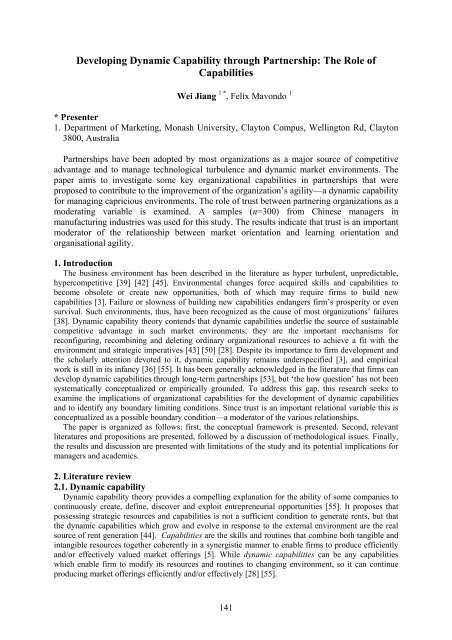Workshop proceeding - final.pdf - Faculty of Information and ...
Workshop proceeding - final.pdf - Faculty of Information and ...
Workshop proceeding - final.pdf - Faculty of Information and ...
You also want an ePaper? Increase the reach of your titles
YUMPU automatically turns print PDFs into web optimized ePapers that Google loves.
Developing Dynamic Capability through Partnership: The Role <strong>of</strong><br />
Capabilities<br />
Wei Jiang 1 * , Felix Mavondo 1<br />
* Presenter<br />
1. Department <strong>of</strong> Marketing, Monash University, Clayton Compus, Wellington Rd, Clayton<br />
3800, Australia<br />
Partnerships have been adopted by most organizations as a major source <strong>of</strong> competitive<br />
advantage <strong>and</strong> to manage technological turbulence <strong>and</strong> dynamic market environments. The<br />
paper aims to investigate some key organizational capabilities in partnerships that were<br />
proposed to contribute to the improvement <strong>of</strong> the organization’s agility—a dynamic capability<br />
for managing capricious environments. The role <strong>of</strong> trust between partnering organizations as a<br />
moderating variable is examined. A samples (n=300) from Chinese managers in<br />
manufacturing industries was used for this study. The results indicate that trust is an important<br />
moderator <strong>of</strong> the relationship between market orientation <strong>and</strong> learning orientation <strong>and</strong><br />
organisational agility.<br />
1. Introduction<br />
The business environment has been described in the literature as hyper turbulent, unpredictable,<br />
hypercompetitive [39] [42] [45]. Environmental changes force acquired skills <strong>and</strong> capabilities to<br />
become obsolete or create new opportunities, both <strong>of</strong> which may require firms to build new<br />
capabilities [3]. Failure or slowness <strong>of</strong> building new capabilities endangers firm’s prosperity or even<br />
survival. Such environments, thus, have been recognized as the cause <strong>of</strong> most organizations’ failures<br />
[38]. Dynamic capability theory contends that dynamic capabilities underlie the source <strong>of</strong> sustainable<br />
competitive advantage in such market environments; they are the important mechanisms for<br />
reconfiguring, recombining <strong>and</strong> deleting ordinary organizational resources to achieve a fit with the<br />
environment <strong>and</strong> strategic imperatives [43] [50] [28]. Despite its importance to firm development <strong>and</strong><br />
the scholarly attention devoted to it, dynamic capability remains underspecified [3], <strong>and</strong> empirical<br />
work is still in its infancy [36] [55]. It has been generally acknowledged in the literature that firms can<br />
develop dynamic capabilities through long-term partnerships [53], but ‘the how question’ has not been<br />
systematically conceptualized or empirically grounded. To address this gap, this research seeks to<br />
examine the implications <strong>of</strong> organizational capabilities for the development <strong>of</strong> dynamic capabilities<br />
<strong>and</strong> to identify any boundary limiting conditions. Since trust is an important relational variable this is<br />
conceptualized as a possible boundary condition—a moderator <strong>of</strong> the various relationships.<br />
The paper is organized as follows: first, the conceptual framework is presented. Second, relevant<br />
literatures <strong>and</strong> propositions are presented, followed by a discussion <strong>of</strong> methodological issues. Finally,<br />
the results <strong>and</strong> discussion are presented with limitations <strong>of</strong> the study <strong>and</strong> its potential implications for<br />
managers <strong>and</strong> academics.<br />
2. Literature review<br />
2.1. Dynamic capability<br />
Dynamic capability theory provides a compelling explanation for the ability <strong>of</strong> some companies to<br />
continuously create, define, discover <strong>and</strong> exploit entrepreneurial opportunities [55]. It proposes that<br />
possessing strategic resources <strong>and</strong> capabilities is not a sufficient condition to generate rents, but that<br />
the dynamic capabilities which grow <strong>and</strong> evolve in response to the external environment are the real<br />
source <strong>of</strong> rent generation [44]. Capabilities are the skills <strong>and</strong> routines that combine both tangible <strong>and</strong><br />
intangible resources together coherently in a synergistic manner to enable firms to produce efficiently<br />
<strong>and</strong>/or effectively valued market <strong>of</strong>ferings [5]. While dynamic capabilities can be any capabilities<br />
which enable firm to modify its resources <strong>and</strong> routines to changing environment, so it can continue<br />
producing market <strong>of</strong>ferings efficiently <strong>and</strong>/or effectively [28] [55].<br />
141
















